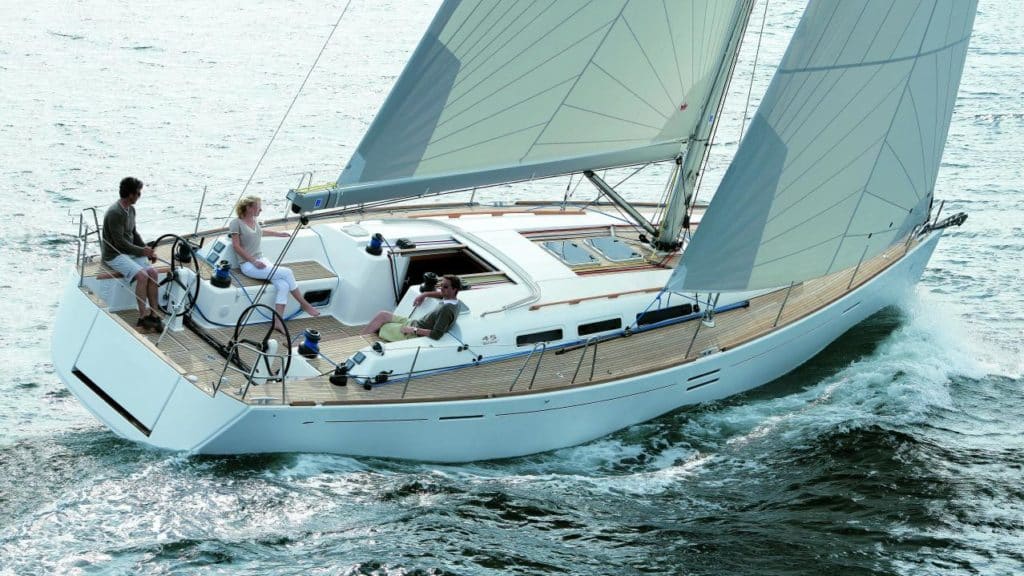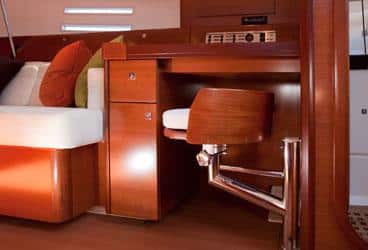
In 1964, a French engineer with a fondness for sailing named Michel Dufour opened a shipyard in the historic seaport of La Rochelle, and in the nearly five decades since then, Dufour and his successors have built and launched literally thousands of boats renowned for their sweet, even exquisite, sailing characteristics.
I haven’t reviewed them all, of course, but I’ve sailed quite a few. So I’ll put it simply, and without exaggeration: The new Dufour 45e Performance has to be one of the finest, purest, best-sailing boats of them all (see the complete photo gallery here).
Happily, some pretty good sailors—the judging panel for Cruising World’s 2011 Boat of the Year contest—concur with that estimation. For when the votes were tallied in the category of Best Cruiser, 40 to 49 Feet, the clear winner was this very versatile, almost-46-foot performance machine. And in the aftermath, the judges made it very apparent that the boat’s excellent speed and handling when the sails were hoisted played a significant role in how they cast their votes.
“Walking up to it on the dock, it didn’t seem like anything special,” said Ed Sherman. “But it was a whole different beast when we were out on the water. It’s a great sailboat.”
“The helm was dreamy,” added Tim Murphy, “maybe the best helm we’ve had, bar none.”
“If Dad’s going to override Mom on any boat we tested this year,” said Beth Leonard, “it’s going to be this one.”
Actually, there are plenty of features on the 45e that will bide for Mom’s attentions, too, and we’ll get to those soon. But for the moment, let’s focus on what makes this slippery, maneuverable, midsize cruiser/racer such a joy to sail. (Note: This really is the rare dual-purpose boat that will excel at each endeavor. To paraphrase one judge, “You could race this boat to Bermuda with your buddies, then take the kids cruising up to Maine for three weeks, and it would be perfect for both.”)

The triple-spreader rig, with a fully battened main, comes in two versions, an Intracoastal Waterway-friendly 63-foot mast (which can be coupled with a 6-foot-4-inch keel), or the taller, 68-foot spar (paired with a 7-foot-6-inch appendage). Our test boat was the latter model, and even though it was its first day of U.S. trials, on Chesapeake Bay, and it was saddled with a slightly smaller headsail than the conditions warranted, the 45e sailed like a witch. In 10 to 12 knots of ideal breeze, it trucked to weather at a solid 7.5 to 8 knots, and when the wind faltered a bit into the single digits, it still averaged out at just less than 7 knots. Unfortunately, we didn’t have a kite on board, though one can safely assume that the boat would be an absolute flyer sailing downwind with a spinnaker.
The numbers, however, don’t begin to tell the story. Tim Murphy was correct: Driving the 45e from either of the twin “faux carbon” wheels, which are stationed well aft and outboard, is a sensual, almost ethereal experience. (By the way, you see dual helms on so many contemporary cruising boats because, as with the 45e, the beam is carried so far aft that a single, gargantuan wheel would be unwieldy and impractical.) Helm response, to even the slightest adjustment, is immediate. Friction is non-existent. In the puffs, the 45e heels ever so slightly and carries on with business as the knotmeter ascends in accordance.
The deck layout is set up in such a manner that it would be incredibly easy to sail solo, with the primary and double-ended mainsheet winches within handy reach of the skipper. So is the traveler, which spans the entire cockpit sole, just forward of the wheel. My one quibble with this arrangement would be in a round-the-buoys racing scenario; in tacks and jibes, there’d be a lot of hands at work in a rather compact amount of real estate. For cruising or shorthanded sailing, however, the layout is just fine.
In keeping with the latest generation of Dufour models, the profile is low and streamlined. The recessed Facnor headsail-furling drum is a neat touch—as Beth Leonard pointed out, exposed, deck-mounted furlers get salty and trashed on offshore passages. The bow roller/extension for the ground tackle, frankly, appears a bit undersized for a boat of this size. Otherwise, there’s just a whole lot to like from stem to stern, including the adjustable sheet leads, the rigid vang, the very spacious cockpit, and the walk-through transom, which folds down to reveal a quite generous platform for swimming or boarding.
Down below, there’s a choice of three or four cabins. Both have the owner’s stateroom forward with an attached, private head, but the four-cabin model borrows a bit of space to starboard for the extra compartment, with bunk bed-style upper and lower single berths. Each version of the boat sports a pair of separate, roomy double cabins aft.
At the foot of the companionway, a good-size galley to port—with gimbaled stove, top- and front-loading fridge, and more than ample Corian counter space—opposes the simple but useful navigation station and the second head; it’s nice to have all these areas close to the cockpit, for both ventilation and accessibility. The central saloon is focused around a wraparound settee and dining table to port, just across from another long settee to starboard. Both of the settees in the saloon will make fine sea berths. In many ways, it’s a marriage of a traditional accommodation plan with modern styling and aesthetics, and one that will serve the crew well both when under way and dockside.
In other words, Mom will feel right at home.
Everyone, of course, goes cruising for different reasons. But the BOTY judges felt strongly—and I agree—that an enjoyable sailing experience should be a big part of the equation. To borrow a French phrase, the Dufour 45e’s raison d’être—the very core and essence of its conception—is fast, comfortable outings and passages under sail. To all who were involved in the boat’s creation, we’ll conclude this review with one last familiar term to our friends in France.
Bravo.
LOA: 45′ 8″ (13.9 m.)
LWL: 39′ 9″ (12.2 m.)
Beam: 14′ 10″ (4.3 m.)
Draft (std./deep): 6′ 4″/7′ 5″ (1.9/2.3 m.)
Sail Area: 1,217 sq. ft. (113 sq. m.)
Ballast: 7,341 lb. (3,330 kg.)
Displacement: 23,964 lb. (10,870 kg.)
Ballast/D: 30.6
D/L: 67
SA/D: 23.4
Water: 140 gal. (530 l.)
Fuel: 66 gal. (250 l.)
Holding: 13 gal. (49 l.)
Mast Height (std./tall): 63′ 0″/68′ 0″ (19.2/20.7 m.)
Engine: 55-hp. diesel
Designers: Umberto Felci/Patrick Roséo
Price: $403,000
Dufour Yachts
(352) 871-0362
www.dufour-yachts.com








